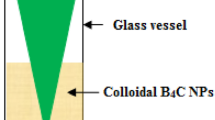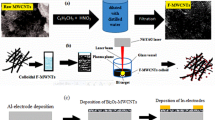Abstract
The synthesis of advanced and hard nanoparticles has attracted considerable interest because of their industrial and technological uses. The most crucial factor in selecting the best preparation method is the ability to control the morphology and size of the nanoparticles. Herein, we report for the first time the effect of laser fluence on the properties of boron carbide (BxC) nanoparticles (NPs) synthesized via pulsed laser ablation in ethanol. The X-ray diffraction results revealed that the synthesized BxC nanoparticles are polycrystalline with a rhombohedral phase. As laser fluence increased, the direct optical energy gap of BxC decreased from 2.16 to 1.94 eV. Fluorescence measurement shows a strong single emission peak centered at 580, 610, and 622 nm is observed for samples prepared at 6.3, 12.7, and 19.1 J/cm2/pulse, respectively. Raman spectra of BxC nanoparticles show the existence of seven vibration modes located at 270, 320, 480, 533, 722, 820, and 1080 cm-1 and their intensity depends on the laser fluence. The field emission scanning electron microscope (FESEM) investigation displays the production of spherical nanoparticles of different sizes, and particle agglomeration was noticed at 19.1 J/cm2/pulse. The fabrication and characterization of BxC NPs/SiO2/Si heterojunction photodetectors is demonstrated. The dark I-V characteristics of the BxC NPs/SiO2/Si heterojunction confirmed the best junction characteristics were found for the heterojunction fabricated at 19.1 J/cm2/pulse. The photosensitivity studies show that the maximum detector's responsivity was 0.78 A/W at 450 nm. The highest values of specific detectivity and quantum efficiency were 2.61 × 1012 Jones and 2.1 at 50 nm, respectively. The ON/OFF measurement was performed to investigate the response/recovery time and switch behavior of the photodetectors.
Similar content being viewed by others
Data Availability
Not applicable
References
Domnich V, Reynaud S, Haber R, Chhowalla M (2011) Boron Carbide: Structure, Properties, and Stability under Stress. J Am Ceram Soc 94:3605–3628
Nordel B, Karki S, Nguyen T, Rulis P, Caruso A, Purohit S, Li Han, King S, Dutta D, Gidley D, Lanford W, Paquette M (2015) The influence of hydrogen on the chemical, mechanical, optical/electronic, and electrical transport properties of amorphous hydrogenated boron carbide. J Appl Phys 118:035703
Evenot F (1990) Boron carbide a comprehensive review. J Eur Ceram Soc 6:205e225
Aoqui Shin-ichi, Miyata H, Ohshima T, Ikegami T, Ebihara Kenji (2002) Preparation of boron carbide thin film by pulsed KrF excimer laser deposition process. Thin Solid Films 407:126–131
Zemsky D, Dagdigian P, Bara I (2007) Structure and morphology of pulsed laser depos ited boron carbide films. J Appl Phys Soc 102:104309
Ismail R, Mousa AM, Amin M (2018) Effect of laser fluence on the structural, morphological and optical properties of 2H-PbI2 nanoparticles prepared by laser ablation in ethanol. J Inorg Organomet Polym Mater Soc 28:2365–2374
Saritha HD, Swapna M, Raj V, Ambadas G, Sankararaman S (2018) Natural cotton as precursor for the refractory boron carbide—a hydrothermal synthesis and characterization. Mater Res Express 5:015603
Mortensen M, Sørensen P, Björkdahl O, Jensen M, Gundersenc H, Bjørnholm T (2006) R-Preparation and characterization of Boron carbide nanoparticles for use as a novel agent in T cell-guided boron neutron capture therapy. Appl Radiat Isot Soc 64:315–324
Jazirehpour M, Bahahrvandi H, Alizadeh A, Ehsani N (2011) Facile synthesis of boron carbide elongated nanostructures via a simple in situ thermal evaporation process. Ceram Int Soc 37:1055–1061
Werheit H, Leithe A, Tanaka T, Rotter HW, Schwetz KA (2004) Some properties of single-crystal boron carbide. J Solid State Chem 177:575–579
Davtyan D, Mnatsakanyana R, Liub L, Aydinyana S, Hussainova I (2019) Microwave synthesis of B4C nanopowder for subsequent spark plasma sintering. J Mater Res Technol Soc 8:5823–5832
Chen LW, Hong MH (2022) Functional nonlinear optical nanoparticles synthesized by laser ablation. Opto-Electron Sci 1:210007. https://doi.org/10.29026/oes.2022.210007
Ismail R, Fadhil FA (2014) Effect of electric field on the properties of bismuth oxide nanoparticles prepared by laser ablation in water. J Mater Sci: Mater Electron 25:1435–1440
Tallant DR, Aselage TL, Campbell AN, Emin D (1989) Boron carbide structure by Raman Spectroscopy. Phys Rev B 40:5649–5656
Chauhan A, Schaefer M, Haber R, Hemker K (2019) Experimental observations of amorphization in stoichiometric and boron-rich boron carbide. Acta Mater 181:207–215
Werheit H, Rotter HW, Meyer FD, Hillebrecht H, Shalamberidze SO, Abzianidze TG, Esadze GG (2004) FT-Raman spectra of isotope-enriched boron carbide. J Solid State Chem 177:569–574
Tauc J et al (1996) Optical Properties and Electronic Structure of Amorphous Germanium. Phys Status Solidi B 320:627–637
Tauc J (1972) “Optical Properties of Solids,” Abeles, North Holland, Amsterdam
Werheit H (2006) On excitons and other gap states in boron carbide. J Phys Condens Matter 18:10655
Tucker M (2021) Boron carbide amorphous solid with tunable band gap. J Alloys Compounds 861:157951
Schmechel R, Werheit H, Kampen TU, Mönch W (2004) Photoluminescence of boron carbide. J Solid State Chem 177:566–568
Hong B (2008) Synthesis and photoluminescence property of boron carbide nanowires. Chin Phys 17:4585–4592
Saritha HV, Swapna MS, Ambadas G, Sankararaman S (2018) Optical Emission Diagnosis of Boron Carbide Synthesized Using Natural Carbon Precursors. Optics Spectrosc 125:928–932
Asady H, Salim ET, Ismail RA (2020) Some critical issues on the structural properties of Nb2O5 nanostructure film deposited by hydrothermal technique. In: AIP Conference Proceedings 2213:020183
Minea AA (2019) A Review on Electrical Conductivity of Nanoparticle-Enhanced Fluids. Nanomaterials (Basel) 9:1592. https://doi.org/10.3390/nano9111592
Arife GI, Ahmet T, Korkut A (2016) “Electrical and photoelectrical characteristic investigation of a new generation photodiode based on bromothymol blue dye.” J Phys: Conf Ser 707:012012. https://doi.org/10.1088/1742-6596/707/1/012012
Ismail R, Alwan A, Ahmed A (2017) Preparation and characteristics study of nano-porous silicon UV photodetector. Appl Nanosci 7:9–15
Ismail R, Zaidan S, Kadhim R (2017) Preparation and characterization of aluminum oxide nanoparticles by laser ablation in liquid as passivating and anti-reflection coating for silicon photodiodes. Appl Nanosci 7:477–487
Ismail R, Mousa A, Khashan K, Mohsin M, Hamid M (2016) Synthesis of PbI2 nanoparticles by laser ablation in methanol. J Mater Sci: Mater Electron 27:10696
Ismail RA, Al-Naimi A, Al-Ani AA (2008) Studies on fabrication and characterization of a high-performance Al-doped ZnO/n-Si (111) heterojunction photodetector. Semicond Sci Technol 23(2008):075030
Ismail R, Hamoudi A, K. W, Saleh K (2014) Effect of rapid thermal annealing on the characteristics of amorphous carbon/n-type crystalline silicon heterojunction solar cells. Mater SciSemicond Process 21:194–199
Ismail R, Al-Naimi A, Al-Ani A (2008) Studies on fabrication and characterization of a high-performance Al-doped ZnO/n-Si (111) heterojunction photodetector. Semicond Sci Technol 23:075030
Ismail RA, Raouf D, Raouf DF (2006) High efficiency In2O3/c-Si heterojunction solar cells produced by rapid thermal oxidation. J Optoelectron Adv Mater 8:1443–1446
Ismail RA, Habubi NF, Abbod MM (2016) Preparation of high-sensitivity In2S3/Si heterojunction photodetector by chemical spray pyrolysis. Opt Quant Electron 48:1–14
Bahjat HH, Ismail RA, Sulaiman GM, Jabir MS (2021) Magnetic Field-Assisted Laser Ablation of Titanium Dioxide Nanoparticles in Water for Anti-Bacterial Applications. J Inorg Organomet Polym 31:3649–3656
Author information
Authors and Affiliations
Contributions
Raid and Asmiet conceived of the presented idea.
Asmiet and Raid supervised the finding of this work.
All authors discussed the results and contributed equally to the final manuscript.
Salah and Raid conducted the experiments.
Asmiet and Salah analyzed and discussed the output of simulated results.
All authors provided critical feedback and helped shape the research, analysis and manuscript.
Corresponding author
Ethics declarations
Ethics Approval and Consent to Participate
Not applicable
Consent for Publication
Not applicable
Competing Interests
The authors have declared that no competing interests exist.
Conflict of Interest
The authors have declared no conflict of interest.
Additional information
Publisher's Note
Springer Nature remains neutral with regard to jurisdictional claims in published maps and institutional affiliations.
Rights and permissions
Springer Nature or its licensor (e.g. a society or other partner) holds exclusive rights to this article under a publishing agreement with the author(s) or other rightsholder(s); author self-archiving of the accepted manuscript version of this article is solely governed by the terms of such publishing agreement and applicable law.
About this article
Cite this article
Hamd, S.S., Ramizy, A. & Ismail, R.A. Fabrication of Visible-Enhanced BxC/SiO2/Si Photodetector by One-Step Laser ablation. Silicon 15, 4247–4257 (2023). https://doi.org/10.1007/s12633-023-02349-y
Received:
Accepted:
Published:
Issue Date:
DOI: https://doi.org/10.1007/s12633-023-02349-y




